Hey there travel enthusiasts and welcome to my post where will cover my 10 best Balinese recipes to savor the flavor with this year. Balinese food is one of my favorites and eating “all the Gorengs” is something my wife and I say all the time.
So if you are looking to try this at home, let’s then have a look at some of the best.
Best Balinese Recipes
As above, Balinese food has something for everyone. Some are spicy, others not so much and in almost all of them (it is after all a bit hard to substitute a whole pig) you can change out the meat for vegetarian or vegan options as well.
Here they are:
Book your food odyssey to Bali here!
1. Balinese Satay
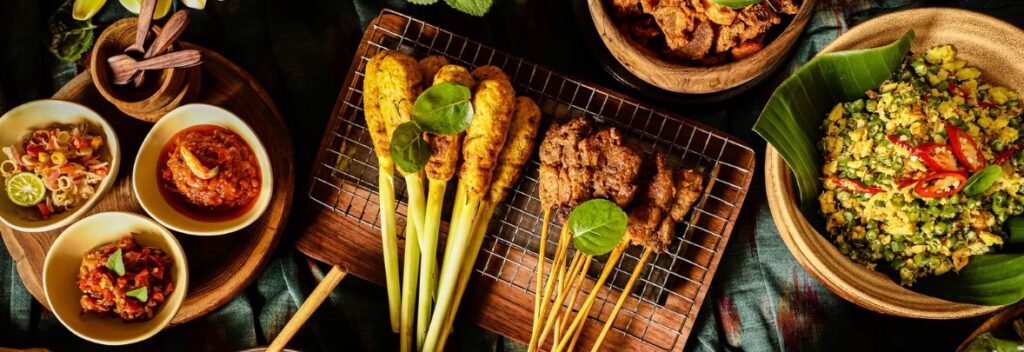
Balinese Satay, also known as Sate, is a skewered meat dish that is marinated in a flavorful blend of spices and grilled to perfection. The dish is usually served with a side of peanut sauce and rice.
To make Balinese Satay, you can use a variety of meats such as chicken, beef, pork or even fish – and of course you can use vegetables or Tofu instead. The meat is cut into small pieces and then marinated in a mixture of spices that typically includes shallots, garlic, ginger, turmeric, coriander and nutmeg. The meat is then skewered and grilled until it is cooked through.
One of the unique things about Balinese Satay is the use of a special spice blend called bumbu. This blend is made up of a variety of ingredients such as lemongrass, galangal and kaffir lime leaves and adds a distinct flavor to the dish that is both fragrant and spicy.
To serve Balinese Satay, it is traditionally accompanied by a peanut sauce that is made up of peanuts, garlic and chili peppers. The sauce is typically sweetened with palm sugar and flavored with tamarind and lime juice. It adds a rich and creamy texture to the dish that complements the meat perfectly.
Ingredients:
For the Satay:
- 1 pound of chicken, beef, or pork, thinly sliced or diced
- Bamboo skewers, soaked in water for 30 minutes
- 2 tablespoons soy sauce
- 1 tablespoon vegetable oil
- 1 tablespoon brown sugar
- 2 garlic cloves, minced
- 1 teaspoon ground coriander
- 1 teaspoon ground turmeric
- Salt and pepper to taste
For the Sauce:
- 1 cup roasted peanuts or peanut butter
- 1 garlic clove, minced
- 1 small chili pepper, minced (adjust to your heat preference)
- 1 tablespoon soy sauce
- 1 tablespoon brown sugar or palm sugar
- 1 teaspoon tamarind paste or lime juice
- 1/2 cup water
- Salt to taste
Instructions:
- Marinate the Meat: In a bowl, combine the meat with soy sauce, vegetable oil, brown sugar, minced garlic, ground coriander, ground turmeric, salt and pepper. Cover and let marinate for at least 1 hour, or overnight for best results.
- Prepare the Skewers: Thread the marinated meat onto the soaked bamboo skewers.
- Grill the Satay: Preheat a grill or grill pan over medium-high heat. Grill the skewers for 3-5 minutes on each side or until cooked through and slightly charred.
- Make the Sauce: While the meat is grilling, you can prepare the sauce. In a blender or food processor, combine the peanuts or peanut butter, garlic, chili pepper, soy sauce, brown sugar, tamarind paste and water. Blend until smooth, adding more water if necessary to reach the desired consistency. Taste and adjust seasoning with salt or more sugar if needed.
- Simmer the Sauce: Pour the sauce into a saucepan and simmer on low heat for 5-10 minutes, stirring occasionally. The sauce should thicken slightly.
- Serve: Serve the grilled satay with the sauce on the side. It pairs well with steamed rice and a simple cucumber salad.
- Optional Garnish: Garnish with chopped cilantro or fried shallots if desired.
Notes:
- You can also use fish or tofu for a different variation.
- If using wooden or bamboo skewers, make sure to soak them in water for at least 30 minutes to prevent burning.
- You can also add some lemongrass to the marinade for an additional layer of flavor.
2. Babi Guling

Babi Guling, also known as Balinese Roast Pork, is a traditional Balinese dish that is made by roasting a whole pig over an open fire, stuffed with a fragrant spice paste made from chilies, turmeric, garlic, ginger and other herbs and spices. The result is a succulent and flavorful meat with crispy skin that is perfect for special occasions and celebrations.
To make Babi Guling, the pork belly is first rubbed with salt and set aside. Then, a spice paste is made by processing ingredients like chilies, turmeric, garlic and ginger in a food processor until a fine paste forms. The pork is then stuffed with the spice paste and roasted over an open fire until it is cooked through and the skin is crispy.
Babi Guling is typically served with steamed rice, vegetables and sambal, a spicy chili sauce. It is a popular dish in Bali, where it can be found in many warungs, or small family-owned restaurants.
While traditionally made over an open fire, Babi Guling can also be made in a home oven. It is important to note that this dish requires a significant amount of preparation and cooking time, so it is best suited for special occasions and celebrations. Try this Babi Guling recipe:
Ingredients:
For the Spice Paste:
- 5 shallots, peeled and chopped
- 4 garlic cloves, peeled and chopped
- 3-inch piece of fresh ginger, peeled and chopped
- 3-inch piece of fresh galangal, peeled and chopped
- 2-inch piece of fresh turmeric, peeled and chopped (or 2 teaspoons turmeric powder)
- 3 stalks of lemongrass, tough outer layers removed, chopped
- 5 bird’s eye chilies, chopped (adjust to taste)
- 2 tablespoons coriander seeds
- 1 tablespoon black peppercorns
- 1 tablespoon salt
- 1 teaspoon shrimp paste (optional)
For the Pork:
- 1 whole suckling pig, cleaned and gutted (or a pork shoulder or loin for a smaller version)
- 3 tablespoons vegetable oil
- 5-6 banana leaves or aluminum foil
- Salt to taste
Instructions:
- Prepare the Spice Paste: In a food processor or mortar and pestle, grind together the shallots, garlic, ginger, galangal, turmeric, lemongrass, chilies, coriander seeds, peppercorns, salt and shrimp paste until a smooth paste forms.
- Marinate the Pork: Rub the spice paste all over the inside and outside of the pork. Be sure to cover it evenly. Let it marinate for at least 4 hours, or overnight for best results.
- Wrap the Pork: If using a whole pig, truss the pig to a spit. For smaller cuts, wrap the pork in banana leaves or aluminum foil.
- Preheat the Oven or Prepare the Spit: If you’re roasting in an oven, preheat it to 325°F (160°C). If you’re using a spit, prepare the fire.
- Roast the Pork: Place the pork in the oven or on the spit over the fire. Roast for about 3-4 hours (for a whole pig) or 1-2 hours for smaller cuts, or until the internal temperature reaches 160°F (70°C). Baste the pork with vegetable oil occasionally to keep it moist.
- Unwrap and Brown: Remove the banana leaves or foil, increase the oven temperature to 425°F (220°C), and roast for an additional 15-20 minutes until the skin is crispy and golden brown. If using a spit, you can baste with more oil and allow the skin to crisp over the open flame.
- Rest and Carve: Remove the pork from the oven or spit and let it rest for 15-20 minutes before carving.
- Serve: Serve the Babi Guling with steamed rice, a vegetable dish like sautéed water spinach, and sambal (spicy chili sauce) on the side.
Notes:
- Making Babi Guling is an involved process that takes time and attention. If you’re making it for a special occasion, you may want to practice with smaller cuts first.
- Adjust the amount of chili to your taste. Traditional Babi Guling can be quite spicy.
- The spice paste ingredients may vary depending on personal or regional preferences.
- If preparing a whole pig on a spit, it might be wise to seek out a specialty butcher or supplier who can provide a suitable pig and additional cooking advice.
3. Nasi Goreng
Nasi Goreng is a popular Indonesian dish that is enjoyed all over the world – and usually the first thing ordered by many a tourist to Bali. It is a simple and delicious fried rice dish that is typically made with leftover rice, vegetables and a variety of spices.
To make Nasi Goreng, the rice is first stir-fried with garlic, onions and a variety of spices such as turmeric, coriander and cumin. Then, vegetables such as carrots, peas and green beans are added to the mixture. Finally, the dish is topped with a fried egg, crispy fried onions and sliced cucumber and tomatoes.
There are many variations of Nasi Goreng, and each region in Indonesia has its own unique recipe. Some recipes include shrimp, chicken, or beef whilst others are vegetarian. Additionally, some recipes call for the addition of Kecap Manis, a sweet soy sauce that adds a unique flavor to the dish.
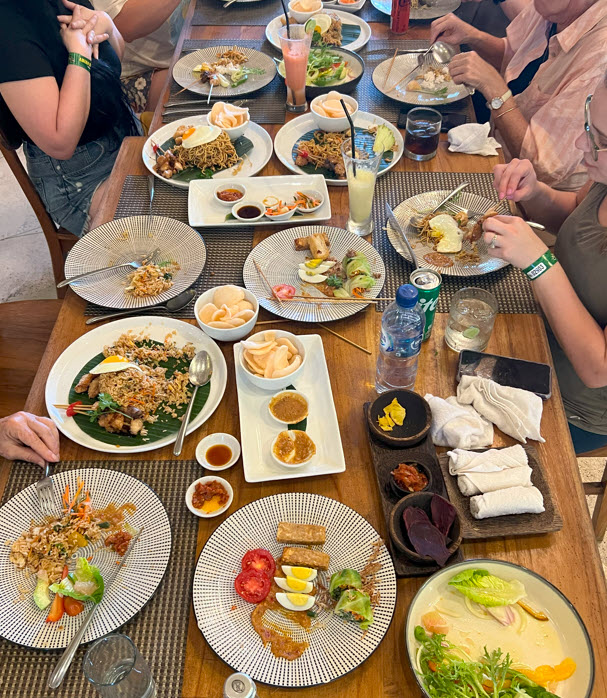
Ingredients:
For the Fried Rice:
- 2 cups of cold, cooked jasmine rice
- 2 tablespoons vegetable oil
- 3 garlic cloves, minced
- 2 shallots, thinly sliced
- 2 eggs, lightly beaten
- 1/2 cup cooked chicken, shrimp, or tofu, diced
- 1/2 cup mixed vegetables (like carrots, peas, or cabbage), chopped
- 3 green onions, chopped
- 2 tablespoons soy sauce
- 1 tablespoon kecap manis (sweet soy sauce), or to taste
- 1 teaspoon sambal oelek or chili sauce (optional, for heat)
- Salt and pepper to taste
- Lime wedges for serving
For Garnish (Optional):
- Fried shallots
- Fresh cilantro, chopped
- Cucumber slices
- Tomato slices
Instructions:
- Prep the Rice: If you haven’t already, cook the jasmine rice and let it cool completely. Day-old rice works best for fried rice as it’s a little drier and won’t become mushy.
- Fry the Egg: In a wok or large pan, heat 1 tablespoon of oil over medium heat. Pour in the beaten eggs and scramble them until fully cooked. Remove from the pan and set aside.
- Sauté Garlic and Shallots: In the same pan, heat the remaining oil over medium-high heat. Add the garlic and shallots, sautéing until they’re fragrant and golden.
- Add Protein and Vegetables: Add your chosen protein (chicken, shrimp, or tofu) and mixed vegetables to the pan. Cook, stirring occasionally, until they’re heated through.
- Fry the Rice: Increase the heat to high and add the rice to the pan. Break up any clumps and stir to combine with the other ingredients.
- Season: Pour in the soy sauce, kecap manis and sambal oelek if using. Stir well to ensure the sauces are evenly distributed. Season with salt and pepper to taste.
- Add the Scrambled Eggs: Return the cooked scrambled eggs to the pan, breaking them into small pieces and mixing well with the rice.
- Add the Green Onions: Stir in the green onions and cook for another minute.
- Serve: Serve the Nasi Goreng hot, garnished with fried shallots, cilantro, cucumber, and tomato slices if desired. Lime wedges can be squeezed over the top for added zing.
Notes:
- Nasi Goreng can be a meal in itself or part of a larger Indonesian feast.
- Feel free to customize with your favorite proteins and vegetables.
- If you don’t have kecap manis, you can make a substitute by simmering regular soy sauce with a little brown sugar until slightly thickened.
4. Bebek Betutu
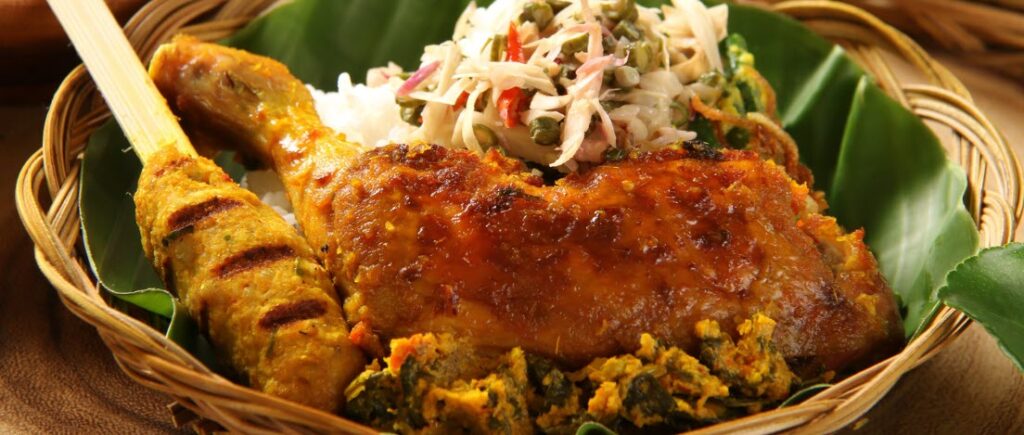
Bebek Betutu is a traditional Balinese dish that consists of roasted duck cooked with a blend of spices and herbs. It is a popular dish that is often served during special occasions and ceremonies. The dish is known for its tender and juicy meat, with a flavorful and aromatic taste.
To make Bebek Betutu, the duck is first cleaned and seasoned with a blend of spices, including turmeric, ginger, garlic, shallots and shrimp paste. The duck is then wrapped in banana leaves and roasted for several hours until it is fully cooked. The result is a delicious and aromatic dish that is perfect for any occasion.
Ingredients:
For the Spice Paste:
- 5 shallots, peeled and chopped
- 3 cloves garlic, peeled and chopped
- 3-inch piece of fresh ginger, peeled and chopped
- 3-inch piece of fresh turmeric, peeled and chopped
- 2-inch piece of galangal, peeled and chopped
- 4 stalks of lemongrass, tough outer layers removed, chopped
- 5 bird’s eye chilies, chopped (adjust to taste)
- 2 tablespoons coriander seeds
- 1 tablespoon black peppercorns
- 2 teaspoons shrimp paste (optional)
- Salt to taste
For the Duck:
- 1 whole duck, cleaned and gutted
- 2 tablespoons vegetable oil
- 2-3 banana leaves (or aluminum foil)
- Salt to taste
For the Side Dish (Optional):
- Steamed rice
- Sambal (Balinese chili sauce)
- Simple Balinese vegetable salad
Instructions:
- Prepare the Spice Paste: In a food processor or mortar and pestle, grind together all the ingredients for the spice paste until a smooth paste forms.
- Marinate the Duck: Rub the spice paste all over the duck, inside and out, and let it marinate for at least 4 hours, or overnight in the refrigerator for the best results.
- Preheat the Oven: Preheat the oven to 300°F (150°C).
- Wrap the Duck: Lay the banana leaves on a clean surface, and place the duck on top. Wrap the duck tightly with the banana leaves, securing with kitchen twine if necessary. If you don’t have banana leaves, use aluminum foil.
- Roast the Duck: Place the wrapped duck in a roasting pan and roast for 3-4 hours or until the meat is tender and cooked through.
- Unwrap and Brown: Carefully unwrap the duck, increase the oven temperature to 425°F (220°C) and roast for an additional 15-20 minutes until the skin is crispy and golden brown.
- Rest and Carve: Remove the duck from the oven and let it rest for 15-20 minutes before carving.
- Serve: Serve the Bebek Betutu with steamed rice, sambal, and a Balinese vegetable salad if desired.
Notes:
- Bebek Betutu is traditionally slow-cooked, so take your time with the roasting process. The longer and slower you roast, the more flavorful and tender the meat will be.
- Adjust the amount of chili in the spice paste according to your taste preferences.
- You can also stuff the duck cavity with additional herbs or aromatic Balinese spices for more flavor.
- If you want to be more authentic, you can also smoke the duck for a few hours using natural wood chips before roasting. This adds an extra layer of flavor that resembles the traditional method.
5. Lawar
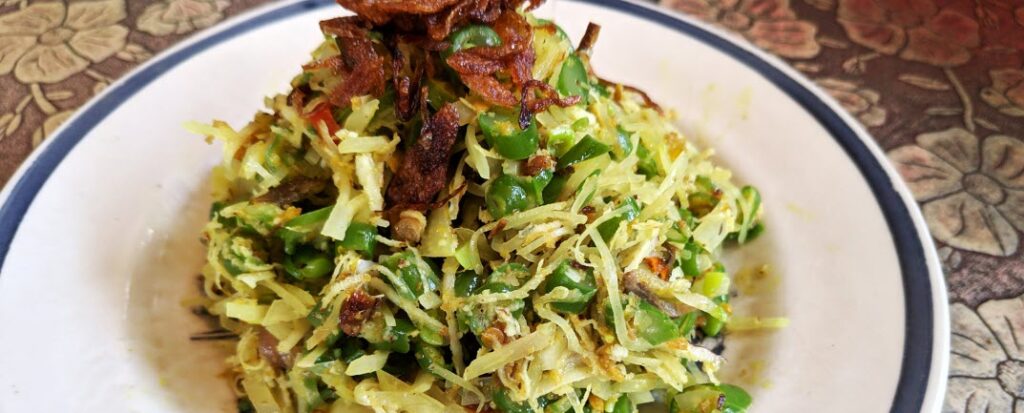
Lawar is a traditional Balinese salad made with a mixture of vegetables, herbs and spices. It is a popular dish served during ceremonies and special occasions and as with many Balinese dishes, there are many variations. However the most common ones are Lawar Ayam (chicken Lawar) and Lawar Babi (pork Lawar).
To make Lawar, a spice paste called base Genep is first prepared. This paste consists of various ingredients such as galangal, turmeric, ginger, shallots, garlic and chili peppers. The paste is then mixed with cooked vegetables such as long beans, grated coconut and sometimes even meat or blood sausage.
Ingredients:
For the Spice Paste:
- 4 garlic cloves, peeled
- 3 shallots, peeled
- 3 bird’s eye chilies (adjust to taste)
- 1-inch piece of galangal, peeled
- 1-inch piece of fresh turmeric, peeled
- 1 teaspoon shrimp paste (optional)
- Salt to taste
For the Lawar:
- 1 cup green beans, finely chopped
- 1 cup grated fresh coconut
- 1/2 cup pork, boiled and finely chopped (optional)
- 1/2 cup fresh young jackfruit, boiled and finely chopped (optional)
- 2 tablespoons vegetable oil
- 2 kaffir lime leaves, thinly sliced
- 1 stalk lemongrass, thinly sliced
- Juice of 1 lime
- Salt and pepper to taste
Instructions:
- Prepare the Spice Paste: In a mortar and pestle or food processor, grind the garlic, shallots, chilies, galangal, turmeric, shrimp paste and salt into a smooth paste.
- Cook the Green Beans: In a pot of boiling water, blanch the green beans for 1-2 minutes until they are bright green but still crisp. Drain and set aside.
- Cook the Spice Paste: Heat the vegetable oil in a pan over medium heat. Add the spice paste, kaffir lime leaves, and lemongrass. Sauté for 5-6 minutes, or until fragrant.
- Combine the Ingredients: In a large bowl, combine the sautéed spice paste, green beans, grated coconut, pork (if using), and young jackfruit (if using). Mix well to ensure that everything is evenly coated with the spices.
- Season: Add lime juice, salt and pepper and adjust the seasoning to your taste.
- Serve: Lawar is typically served at room temperature as a side dish along with steamed rice and other Balinese dishes like Babi Guling or Bebek Betutu.
Notes:
- Lawar can be made with various other meats such as chicken or beef and vegetables like long beans or cabbage. Feel free to experiment with different combinations.
- The inclusion of fresh blood is traditional in some versions of Lawar but is generally omitted in modern or Western interpretations of the dish.
- Adjust the spiciness by using more or fewer chilies as per your preference.
Book your food odyssey to Bali here!
6. Sambal Matah
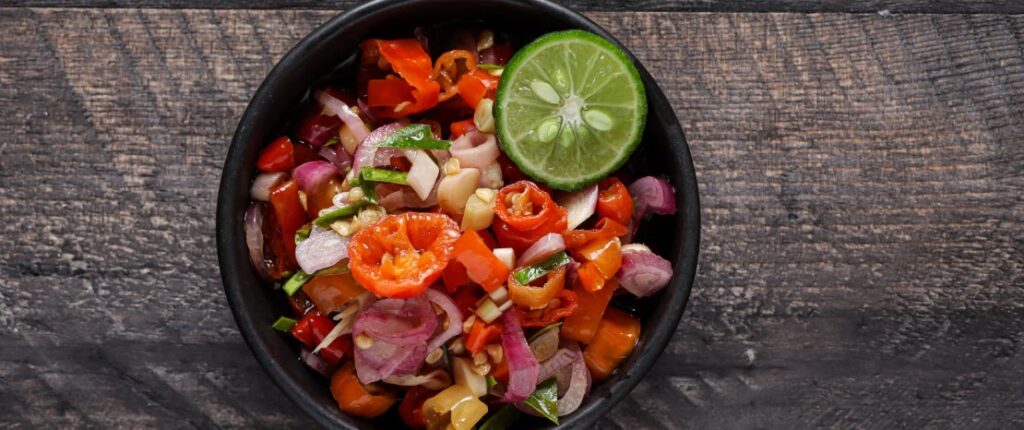
Sambal Matah is a popular Balinese raw sambal recipe that is easy to make and packs a punch of flavor. It is a simple hand-squeezed mixture of raw shallots, salt, oil, hot chillies and kaffir lime leaves. It is a versatile condiment that goes well with grilled, fried and barbecued meat and fish.
To make the authentic Sambal Matah recipe, you will need some bird’s eye chilies, also known as cabe rawit in Javanese. The recipe calls for 10 chilies, but you can of course adjust the number according to their preference for spiciness. Other ingredients include chopped tomato, minced garlic and finely chopped lemongrass.
Ingredients:
- 10 shallots, thinly sliced
- 2-3 bird’s eye chilies, finely chopped (adjust to taste)
- 2 lemongrass stalks, white part only, very thinly sliced
- 1 garlic clove, very finely chopped
- Zest of 1 lime
- Juice of 2 limes
- 1 teaspoon shrimp paste (optional)
- 1/2 teaspoon sugar
- Salt to taste
- 2 tablespoons coconut oil, heated until just melted
Instructions:
- Prepare the Ingredients: Thinly slice the shallots, chilies, lemongrass and garlic as finely as possible. The finer the chop, the better the flavors will meld together.
- Mix the Ingredients: In a mixing bowl, combine the sliced shallots, chilies, lemongrass, garlic, lime zest, lime juice, shrimp paste (if using), sugar and salt.
- Heat the Coconut Oil: In a small saucepan, heat the coconut oil until it is just melted and begins to sizzle. Be careful not to overheat; you want it hot but not smoking.
- Combine with the Oil: Pour the hot coconut oil over the mixed ingredients, and stir well. The hot oil will partially cook the shallots and chilies, mellowing out their raw edge.
- Adjust the Seasoning: Taste the sambal and adjust the seasoning, adding more salt, sugar or lime juice as needed.
- Let It Rest: Allow the Sambal Matah to rest for at least 10 minutes to let the flavors meld together. It can be stored in the refrigerator and used within 2-3 days.
- Serve: Serve Sambal Matah as a condiment with grilled meats, seafood or traditional Indonesian dishes. It adds a fresh, spicy kick to any meal.
Notes:
- The level of spiciness can be adjusted by increasing or decreasing the number of chilies.
- If you find fresh lemongrass challenging to slice thinly, you can pound it a little first to soften the fibers, making it easier to slice.
- If shrimp paste is unavailable or you want to make a vegetarian version, you can omit it without significantly affecting the flavor.
- Some versions of Sambal Matah might include finely chopped kaffir lime leaves for an additional citrusy note.
7. Jukut Urab
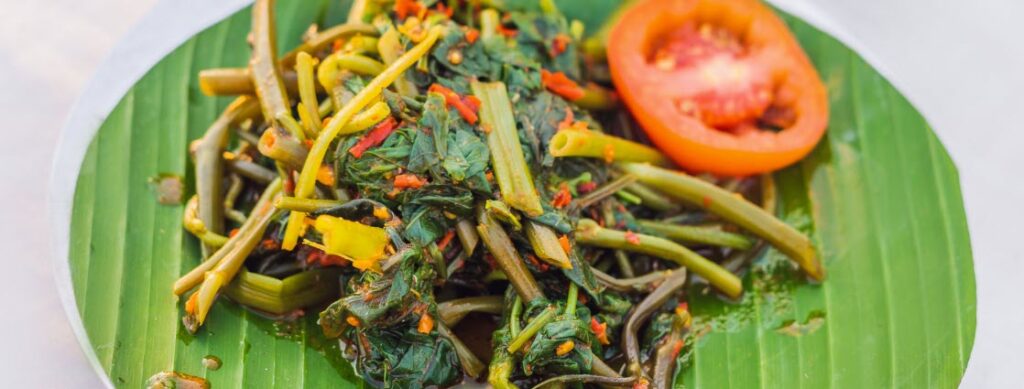
Jukut Urab is a popular Balinese salad-like dish made with blanched vegetables, spiced paste and grated coconut. Jukut Urab is usually served as a side dish or can be enjoyed on its own with steamed rice.
To make Jukut Urab, you will need to blanch snake beans, bean sprouts and young spinach and slice them into half-centimeter sized pieces. Grate the coconut and mix it with the spiced paste made with ingredients like chili, garlic and shrimp paste. The spiced paste is then mixed with the blanched vegetables and grated coconut.
Ingredients:
For the Spice Paste:
- 4 shallots, peeled
- 2 garlic cloves, peeled
- 2 bird’s eye chilies (adjust to taste)
- 1-inch piece of galangal, peeled
- 1 teaspoon shrimp paste (optional)
- Salt to taste
For the Salad:
- 2 cups spinach, blanched and chopped
- 1 cup green beans, blanched and sliced
- 1 cup bean sprouts
- 1 cup grated fresh coconut
- 2 kaffir lime leaves, thinly sliced
- 1 tablespoon palm sugar
- Juice of 1 lime
- Salt to taste
Instructions:
- Prepare the Spice Paste: In a mortar and pestle or food processor, grind the shallots, garlic, chilies, galangal, shrimp paste (if using) and salt into a smooth paste.
- Blanch the Vegetables: In boiling water, quickly blanch the spinach and green beans for 1-2 minutes until they are bright green but still crisp. Drain and plunge into cold water to stop cooking, then drain again.
- Cook the Spice Paste: In a pan over medium heat, sauté the spice paste with a little oil for 3-4 minutes or until fragrant. Remove from heat and allow it to cool.
- Mix the Salad: In a large bowl, combine the blanched spinach, green beans, bean sprouts, grated coconut, kaffir lime leaves, cooked spice paste, palm sugar, lime juice and salt. Mix well to ensure that everything is evenly coated with the spice mixture.
- Adjust the Seasoning: Taste and adjust the seasoning, adding more salt, sugar or lime juice if necessary.
- Serve: Jukut Urab is typically served at room temperature as a side dish with steamed rice and other Balinese dishes like Babi Guling or grilled fish.
Notes:
- Jukut Urab can be made with various other vegetables like cabbage, long beans or water spinach. Feel free to experiment with different combinations.
- Adjust the spiciness by using more or fewer chilies to your taste.
- The inclusion of shrimp paste adds depth to the flavor but can be omitted for a vegetarian version.
- If fresh grated coconut is unavailable, you can use unsweetened desiccated coconut soaked in warm water.
8. Tahu Tempe
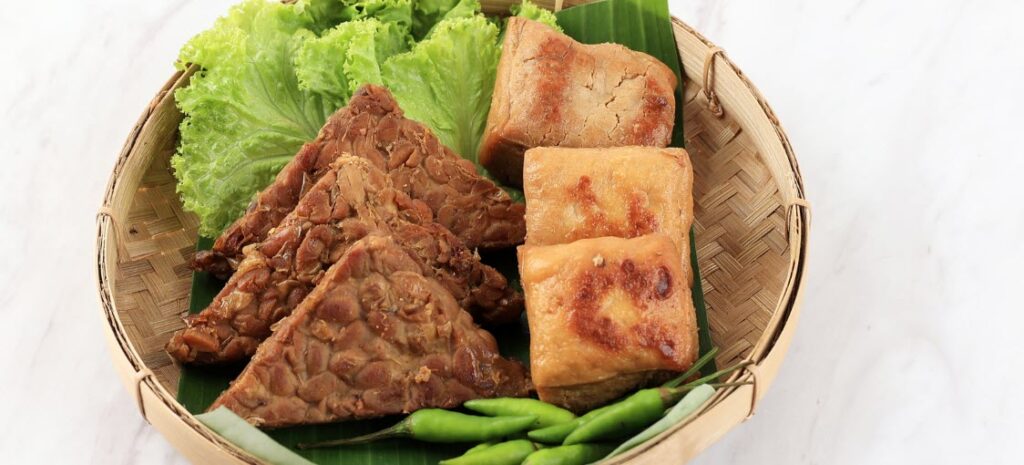
Tahu Tempe is a delicious and healthy dish that is popular in Balinese cuisine. It is made with two main ingredients, tofu (tahu) and tempeh, which are both high in protein and low in fat making it perfect for vegetarians and vegans, as it contains no meat or animal products.
To make Tahu Tempe, first, slice the tofu and tempeh into small pieces. Then, fry them in a wok until they are golden brown. Next, add some chopped garlic, shallots and chili to the wok and fry until they are fragrant.
After that, add some sliced tomatoes and salt to the wok and cook for a few minutes until the tomatoes are soft and juicy. Finally, add some sweet soy sauce and stir until everything is well combined.
Tahu Tempe can be served as a main dish with rice or as a side dish with other Balinese dishes. It is a simple and easy-to-make dish that is packed with flavor and nutrition.
Ingredients:
- 200g tofu, cut into bite-sized cubes
- 200g tempeh, cut into bite-sized pieces
- 2 garlic cloves, minced
- 2 shallots, minced
- 2 bird’s eye chilies, minced (adjust to taste)
- 2 tablespoons soy sauce
- 1 tablespoon sweet soy sauce (kecap manis)
- 1 tablespoon oyster sauce (or vegetarian oyster sauce)
- 1 teaspoon palm sugar or brown sugar
- Salt and pepper to taste
- 3 tablespoons vegetable oil
- 2 green onions, thinly sliced (for garnish)
- Fresh lime wedges (optional, for serving)
Instructions:
- Fry Tofu and Tempeh: Heat 2 tablespoons of vegetable oil in a pan over medium heat. Fry the tofu and tempeh until golden brown on all sides. Remove and set aside.
- Prepare the Sauce: In a small bowl, mix the soy sauce, sweet soy sauce, oyster sauce, palm sugar, salt and pepper. Adjust the seasoning to taste.
- Sauté the Aromatics: In the same pan, add the remaining tablespoon of oil. Sauté the garlic, shallots and chilies until fragrant and soft, about 2-3 minutes.
- Add Tofu and Tempeh Back to the Pan: Return the fried tofu and tempeh to the pan with the aromatics and stir to combine.
- Pour the Sauce: Add the prepared sauce to the pan and stir well to coat the tofu and tempeh evenly. Cook for 3-4 minutes, allowing the flavors to meld together.
- Check the Seasoning: Taste and adjust the seasoning if needed, adding more salt, pepper or soy sauce as desired.
- Garnish: Remove from heat and sprinkle with sliced green onions.
- Serve: Serve hot with steamed white rice and lime wedges, if using.
Notes:
- Tahu Tempe can be made spicier or milder depending on the number of chilies used. Feel free to adjust according to your taste preferences.
- You can add vegetables like bell peppers, carrots or baby corn to increase the dish’s nutritional value.
- If sweet soy sauce (kecap manis) is unavailable, you can substitute it with additional soy sauce and sugar.
9. Sate Lilit

Sate Lilit is a Balinese satay that is made with minced meat, coconut and a blend of fragrant spices. This dish is a popular street food in Bali and is often served as an appetizer or snack. Sate Lilit is traditionally made using lemongrass sticks as skewers, giving the dish a unique flavor and aroma.
To make Sate Lilit, the meat is first minced and mixed with grated coconut, spices and other ingredients like shrimp paste and palm sugar. The mixture is then wrapped around the lemongrass skewers, giving the satay its distinctive shape. Sate Lilit can be made with a variety of meats such as chicken, beef or fish, but the most common meat used is mackerel.
One of the unique features of Sate Lilit is the use of a special spice paste called bumbu. The bumbu is made by blending together a variety of spices including turmeric, ginger, garlic, shallots and chili. This paste is then mixed with the meat and coconut mixture to give the satay its distinctive flavor.
Sate Lilit is typically served with a spicy peanut sauce and a side of steamed rice. It can also be served as a main course, accompanied by a salad or other side dishes.
Ingredients:
For the Spice Paste:
- 4 shallots, peeled
- 3 garlic cloves, peeled
- 2 bird’s eye chilies (adjust to taste)
- 1-inch piece of galangal, peeled
- 1-inch piece of fresh turmeric, peeled
- 1 teaspoon shrimp paste (optional)
- Salt to taste
For the Satay:
- 500g fish, chicken, or pork, minced
- 1 cup grated fresh coconut
- 1/2 cup coconut milk
- 2 kaffir lime leaves, thinly sliced
- 1 stalk lemongrass, thinly sliced
- Salt to taste
- Lemongrass stalks or thick bamboo skewers for wrapping
Instructions:
- Prepare the Spice Paste: In a mortar and pestle or food processor, grind the shallots, garlic, chilies, galangal, turmeric, shrimp paste (if using) and salt into a smooth paste.
- Cook the Spice Paste: Heat a little oil in a pan over medium heat. Add the spice paste and sauté for 5-6 minutes or until fragrant.
- Combine the Satay Ingredients: In a large bowl, combine the minced meat, cooked spice paste, grated coconut, coconut milk, kaffir lime leaves, lemongrass and salt. Mix well to ensure that everything is evenly incorporated.
- Shape the Satay: Take a handful of the mixture and wrap it around the thick end of a lemongrass stalk or bamboo skewer, forming a thick, flat sausage shape.
- Grill the Satay: Preheat a grill or grill pan over medium heat. Lightly oil the grill grates or pan. Grill the satay for 5-7 minutes on each side, or until fully cooked and slightly charred on the edges.
- Serve: Serve Sate Lilit hot with steamed rice and Balinese sambal, such as Sambal Matah.
Notes:
- Sate Lilit can be made with various types of meat, but fish is the most traditional choice.
- Adjust the spiciness by using more or fewer chilies to your taste.
- If using bamboo skewers, soak them in water for at least 30 minutes before using to prevent burning during grilling.
- Fresh lemongrass stalks not only serve as skewers but also infuse the satay with a lovely citrusy flavor as they cook.
10. Nasi Campur
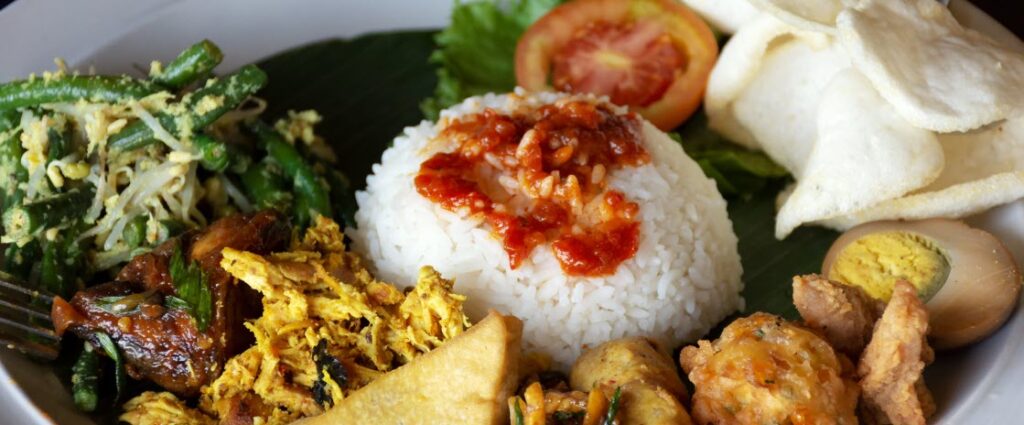
Nasi Campur is a traditional Indonesian dish that translates to “mixed rice” in Indonesian and Malay. It consists of a scoop of steamed rice served with a small portion of many sides, such as fish, chicken, vegetables, eggs and keropok (fried shrimp paste).
To make Nasi Campur, the rice is usually cooked with coconut milk, which gives it a creamy texture and a slightly sweet taste. The sides are usually prepared separately and each one is seasoned with different spices and herbs to give them a unique flavor.
One of the best things about Nasi Campur is that it is very customizable. You can choose which sides you want to include, depending on your preferences. Some popular sides include Ayam Betutu (spicy roasted chicken), Sate Lilit (grilled minced meat on lemongrass skewers), Lawar (vegetable salad with grated coconut), and Sambal Matah (raw shallot and lemongrass chili sauce).
Ingredients:
For the Steamed Rice:
- 2 cups jasmine rice, rinsed
- 2 1/2 cups water
For the Accompaniments (choose a variety as per preference):
- Grilled or fried fish/chicken
- Stir-fried tofu and tempeh
- Sautéed vegetables (spinach, green beans, or cabbage)
- Fried egg or hard-boiled egg
- Sambal or chili sauce
- Fried shallots
- Peanuts or cashews
- Slices of cucumber or tomato for garnish
- Any other favorite Indonesian dishes
Instructions:
- Cook the Rice: Combine the jasmine rice and water in a rice cooker or saucepan. If cooking on the stovetop, bring to a boil, then reduce to a simmer, cover, and cook for 15-20 minutes, or until the rice is tender. Let it sit, covered, for 10 minutes, then fluff with a fork.
- Prepare the Proteins: Grill, fry or bake your chosen proteins (such as fish, chicken, tofu, or tempeh). You can marinate them with Indonesian spices like lemongrass, garlic, shallots and soy sauce for extra flavor.
- Cook the Vegetables: Sauté or steam your chosen vegetables until tender. Season with salt, pepper or any preferred spices.
- Prepare Other Accompaniments: Prepare any other desired accompaniments like frying the eggs, making the sambal or frying the shallots.
- Assemble the Nasi Campur: Place a scoop of steamed rice in the center of each plate. Surround the rice with small portions of your chosen accompaniments. Arrange them neatly around the rice, creating a visually appealing presentation.
- Serve: Serve the Nasi Campur with condiments like soy sauce or sambal on the side. It can be enjoyed as a complete meal that offers a variety of flavors and textures.
Notes:
- The beauty of Nasi Campur is its flexibility. Feel free to include your favorite dishes or ingredients.
- To make it more authentic, include traditional Indonesian dishes like Sate Lilit, Rendang, or Balado.
- Presentation is an essential aspect of Nasi Campur. Take time to arrange the components attractively.
FAQs
What are some traditional Balinese dishes?
Balinese cuisine is known for its rich flavors and use of fresh ingredients. Some of the traditional Balinese dishes include Nasi Campur, Babi Guling, Lawar, Sate Lilit, and Ayam Betutu.
conclusion
There you have it, my 10 best Balinese food recipes to savor this year. I hope it has been helpful and as usual, please let me know of your experiences here.
Also, please do not hesitate to comment below if you have any questions, concerns, or corrections or would like me to check anything else out for you.
Until next time.
Have fun
Paul






